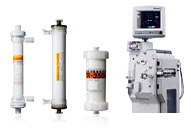Lambert-Eaton myasthenic syndrome (LEMS)
Lambert-Eaton myasthenic syndrome (LEMS) is a disease of the neuromuscular junction characterized by muscle weakness, tingling sensations in affected sites, fatigue, and dry mouth. LEMS is thought to be caused by the production of antibodies targeting antigens in the neuromuscular junction. Corticosteroids, plasmapheresis, and IVIg are used for treatment.
Miller-Fisher syndrome (MFS)
Miller-Fisher syndrome (MFS) is a rare, acquired nerve disorder, considered to be a variant of Guillain-Barré syndrome. The etiology remains unknown but in most cases it occurs after a viral infection. IVIg and plasmapheresis are used for the treatment of MFS.
Multiple myeloma/ Primary macroglobulinemia
Antibodies (immunoglobulins; IgG, IgA, IgM, IgD, IgE) are produced by plasma cells in the bone marrow and play a role in the immune response. The principal cause of multiple myeloma and primary macroglobulinemia is the excessive multiplication of plasma cells by canceration. Abnormal immunoglobulin called IgM or M protein is produced, and the detection of this marker is the key to the diagnosis.
Symptoms of multiple myeloma are lower back pain, back pain, bone pain, lassitude, fatigue, anemia, susceptibility to infection, proneness to fracture, protein in the urine, and elevated erythrocyte sedimentation rate. Common symptoms of primary macroglobulinemia are enlarged lymph nodes, liver, and spleen.
Elevated serum M protein levels increase blood viscosity, leading to circulatory disorders. The resulting deterioration in kidney function is another common symptom of multiple myeloma and primary macroglobulinemia. In addition to medical treatment, double filtration plasmapheresis (DFPP) or plasma exchange (PE) is used to reduce M protein levels to reduce viscosity and improve blood circulation.
Multiple sclerosis (MS)
Multiple sclerosis (MS) is an unpredictable disease of the central nervous system characterized by visual disorders and muscle weakness. MS is thought to be an autoimmune disorder mainly of the Th1-type cellular immune response targeting oligodendrocytes. Treatment includes corticosteroid pulse therapy, corticosteroids in combination with immunosuppressants, and plasmapheresis combined with immunosuppressants.
Myasthenia gravis(MG)
Myasthenia gravis (MG) is a chronic autoimmune neuromuscular disease characterized by varying degrees of skeletal muscle weakness. MG is thought to result from inhibition of neuromuscular transmission by autoantibodies targeting the acetycholine (ACh) receptors on the postsynaptic membrane in the myoneural junction. Treatment for MG includes thymectomy, plasmapheresis, and high-dose intravenous immunoglobulin (IVIg).
Please feel free to send us any questions you may have about our products and support.
Share your feelings and experiences when using our products.





